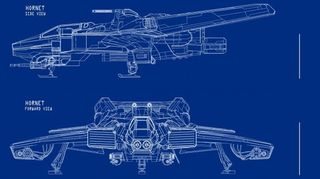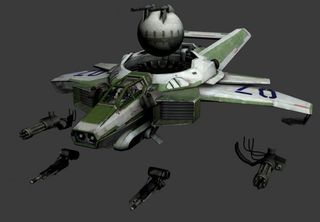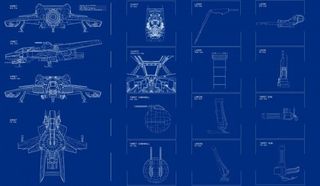Star Citizen's ship customization systems explained

Star Citizen is being billed as a return to form for PC gaming and the space combat genre. It's to be bigger than the rest, more open than the rest, and more detailed than the rest, especially in regard to ship design and handling—the official bullet points describe full rigid body simulation, "Dynamic Ship Maneuverability," and meaningful component decisions. Tasty stuff, but just a sweet glaze of promises on top of the rich, substantial detail filling we're after—and now we have a little more of it.
Roberts Space Industries has given us a sneak peek at the next Star Citizen development update (now posted here ), which details the design plans for the engineering and customization of the ships we'll be piloting through its ambitious universe. Pace yourself—blueprints and spreadsheets are very filling.
The big ideas

"One of the most important rules to remember is that the most expensive parts may not be the right tool for the job, and that even the most decked-out ship can be bested by a skilled pilot in a lesser craft," reads the update. "Our job was to create a system that honored this promise: one where upgrades meant building a ship that speaks to your personal preferences rather than one that's simply the acknowledged all-around best option."
Customization that rewards ingenuity and mechanical understanding over stat vs. stat showdowns sounds brilliant, but like all of Star Citizen's ideas, it's easier said than done. RSI explains how it plans to accomplish the ship and component balancing feat with detailed resource management:
"...Ship modification is a game of resource management where players will juggle space requirements, power consumption, heat load, signature, mass, CPU resources, durability and the cost and availability of parts. We've created a system that allows you to manage all of these individual pieces in intricate detail, but also build a unified whole that will behave the way you want it to without micromanagement during the actual combat."
Despite many distinct differences, EVE Online seems like a valid comparison here—its huge equipment catalog and granular stats share a similar philosophy. Ships in EVE are designed for specific purposes, and while there are a few "best" designs for each hull, there's room for experimentation.
Unlike EVE, however, RSI claims that this intricate systems management will be entirely optional.
PC Gamer Newsletter
Sign up to get the best content of the week, and great gaming deals, as picked by the editors.
"You never NEED to drill down this deep to enjoy Star Citizen," continues the post. "If you're itching to get out there and fight or explore or trade, grab a factory model, add the few parts that you absolutely need, and head for the stars."
The parts of a Star Citizen ship

That's enough on the conceptual stuff—it's time for the nitty-gritty, which is my favorite kind of gritty. RSI has broken down all of a ship's components for us:
- Hull: Hull is where you can mount additional armor for protection, reduce your mass for better handling or modify your cross-section to limit your signature.
- Power Plant: Power Plants supply the power that the rest of your ship will consume. It's the foundation on which all other systems function.
- Avionics: If the Power Plant is the heart of your ship, the avionics are the brain. Avionics calculate the advanced math required for the maneuvering thrusters, track and identify targets, and automatically route power and ensure functional life support. It is unique among systems in that it can also be upgraded with additional systems such as ITTS, better turret AI and a myriad of other options.
- Afterburners: Give a significant boost to thrust at the cost of expelling fuel inefficiently.
- Shield Generators: Protect the ship from spaceborne debris and hostile fire. Generators come in multiple sizes, and have varying levels of segmentation (single 'bubble', front/back, quadrant, etc.)
- Intake: Allows you to scoop free hydrogen in the vacuum of space or in the extreme upper atmosphere of gas giants to refill your working mass tank.
- Fuel Tank: The fuel tanks deliver mass in the form of hydrogen to the power plant, which in turn delivers energy to supercharge the fuel and expel it at speed. If you run out far from civilized space, you better hope you have Triple A! (Your computer will warn you when you reach 'bingo fuel' – the point of no return after which you will not be able to reach a friendly base.)
- Maneuvering Thrusters: Maneuvering thrusters are small thrusters that provide the majority of the pitch, roll and yaw control as well as correcting the ship's velocity vector to be in the direction it's pointing (if the IFCS is on). These can either be fixed in place, or have varying methods of articulation to improve control response.
- Main Thrusters: These provide the bulk of the forward thrust of a ship. Like maneuvering thrusters these can also be fixed in place or have thrust vectoring assist with the directional control of the craft. Articulated thrusters require more robust avionics.
- Miscellaneous: Weapon batteries to assist the recharge function of the energy weapons, ammo racks to store more ballistic ammunition, additional cooling systems to purge heat load, devices to hide your cargo, the list goes on and on…
- Class 1 Weapon: Forward-fixed weapons that can mount larger weapon systems.
- Class 2 Weapon: Gimbal-mounted weapons that have limited pivot in a fixed direction. The increased cone of fire comes at the cost of smaller weapon size.
- Class 3 Hardpoint: Class 3 hardpoints can mount a variety of underbelly gear such as missile racks or extra fuel tanks.
- Class 4 Hardpoint: Generally used to mount turrets, some ships can also use these hardpoints for increased cargo space and other ships systems.
Resource management and pipes
All of these components come with costs and side effects. They require space and power, affect a ship's mass and maneuverability, generate heat, and even affect CPU load and a ship's electromagnetic signature, which avionics systems use to track targets.
There are a lot of interesting implications here. For example, building a great stealth ship means minimizing power consumption, which is a much more interesting idea to me than slapping a stealth-o-matic 2000 into a component slot and being done with it.

Also exciting is performance tuning. Components will be tweakable—like overclocking your CPU, you'll be able to push them past their rated limits, risking damage to the part and other side effects. To alleviate some of the risk, RSI says we'll be able to bench test our equipment in the hanger before taking it into space.
Just like CPU overclocking, RSI says we won't always be able to predict performance gains or side effects, and envisions a market for successfully overclocked upgrades.

Finally, RSI describes how all these components will fit together with "pipes." The PC building analogy is again best: the "power pipe" is your power supply, the "data pipe" is the motherboard which routes information between components, and the heat pipe is presumably your cooling system (can mine have a bunch of LEDs?).
RSI plans for damage to disrupt these pipes with "varying repercussions" that it hopes will foster emergent gameplay. Presumably, this means that your data pipe could be damaged in such a way that weapons systems stop communicating with the HUD, for instance, but RSI doesn't elaborate.
The ideas are fantastic in the complete sense of the word—extraordinary, but unrealized. We know what Star Citizen is supposed to be, and we're starting to learn how it will all work—I can't wait to see if it does. If anyone can implement all this successfully, Wing Commander creator Chris Roberts in definitely among them, and I'll be talking to him more about Star Citizen's ambitions and development status this week at GDC.
Regarding ship customization, you'll find more details on RSI's official site and in its living ship design document .

Tyler grew up in Silicon Valley during the '80s and '90s, playing games like Zork and Arkanoid on early PCs. He was later captivated by Myst, SimCity, Civilization, Command & Conquer, all the shooters they call "boomer shooters" now, and PS1 classic Bushido Blade (that's right: he had Bleem!). Tyler joined PC Gamer in 2011, and today he's focused on the site's news coverage. His hobbies include amateur boxing and adding to his 1,200-plus hours in Rocket League.
Most Popular





